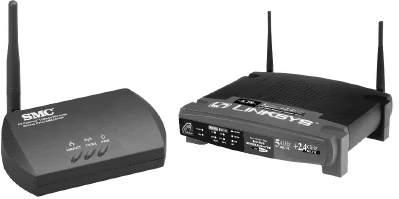Wireless access points (APs), also called wireless base stations, have become a crucial component for any wireless network that goes beyond simple ad hoc status.
The AP performs several important functions, but its primary task in its primary role is to act as a waystation for wireless traffic on the network. Indeed, many wireless networks use multiple APs, each one acting precisely as a waystation, extending the range of the WLAN by offering additional physical points of connection.
In smaller networks, a single AP provides a centralized transmitter and receiver for all PCs on the network, routing traffic to and from the various wireless adapters while supplying all clients with access to one or more wired networks.
Access points come in many shapes, sizes, and configurations (as shown in Figures below).
However, no matter how else they might differ, all APs share the following components:
- Antenna: The primary function of the access point is to transmit and receive radio signals from other wireless devices on the network.
To guarantee the best possibility of doing so, manufacturers attach at least one antenna to the case, and some APs are built with two.
You can adjust the antennae according to your needs, to maintain connectivity with other wireless devices no matter where they might be and no matter what lies between them.
- Ethernet Port: The purpose of an access point is to create an infrastructure network, which means connecting to an existing Ethernet-based network.
This wired network need not be a local area network (LAN); instead, it can be your broadband provider’s wide area network (WAN).
Many APs act as both network routers and Internet sharing devices, and this type offers Ethernet ports for both LAN and WAN connections.
Others offer only one Ethernet port, which you can use to connect either to the broadband provider’s modem or to an external router for your LAN.
In the former case, the AP typically becomes the sole Internet access device for all the WLAN-connected devices you have (often one or more notebook PCs, each with its own PC Card WLAN adapter).
In the latter case, it extends the LAN to any wireless devices, and as such operates similarly to a combined AP and router.
- LED Indicators: Like the vast majority of networking equipment, access points provide small lights (LEDs) that tell you what’s going on at any given time.
In fact, as you start to use your networking equipment together—broadband modem, router, and AP—you’ll quickly discover that you can turn off the overhead lights in the room and have a light show of your own from all the flashing caused by the LEDs.
These LEDs tell you a number of important details, such as whether the AP is making a connection with the wired network and whether it’s transmitting and receiving data from wireless devices.
Use the manual to learn how to read these LEDs, and remember how to do so. If your network doesn’t seem to work, checking them often points to the problem. The same holds true of LEDs on your other networking devices.
- Reset Button: Sometimes you just can’t get the access point functioning, typically after a power outage or after you’ve made significant changes to your network configuration (such as switching from a DSL provider to a cable provider).
In these cases, once you’ve exhausted all configuration options, the reset button can become your best friend. Usually accessible with a pen, pencil, or other similarly shaped small point.
You just press and hold it (often the LEDs tell you when you’ve held it long enough) and the access point reverts to its factory settings. Enter the configuration screens and start the process over.
- Power Cord: Believe it or not, this component matters quite a bit. Access points require their own power source, a fact that restricts the locations in which you can place them.
This requirement usually presents no problem when positioning the primary AP, which especially in an infrastructure network tends to be near the primary PC (to run a networking cable from the AP’s Ethernet ports to the PC’s Ethernet port).
But in many cases you’ll want to place secondary APs in strategic locations for purposes of reception. Sometimes, this means high up on a wall, or even in the attic of a house.
Without power receptacles in those locations, you typically need to run extension cords to the AP, and extension cords pretty well negate the entire concept of wirelessness. Another option is to use Power Over Ethernet products, but these have their own distinct disadvantages.
